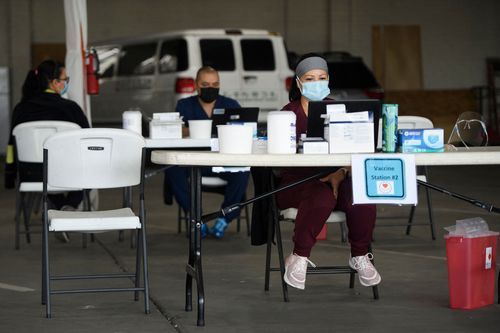The US may have more vaccines than people who want them by mid-May. Here’s why that’s a big problem.

The US will likely soon come up against a significant obstacle in the fight against the Covid-19 pandemic — more doses of the vaccines than people who are willing to receive them, according to data that is worrying experts.
“We actually think that (vaccine) supply will outstrip demand … in probably the middle of May,” Dr. Chris Murray, chair of the Institute for Health Metrics and Evaluation (IHME) at the University of Washington, told CNN Friday.
The Kaiser Family Foundation earlier this week predicted something similar.
The foundation cited the percentage of survey respondents that said they’ve already received the vaccine or would get it as soon as they could — 62%.
Weighing that against the daily rate of vaccinations, and the CDC’s data showing more than 41% of US adults already have had at least one dose, it’s possible that the vast majority of US adults who presently want a first dose will have received them by early- to mid-May, the KFF said.
One modifying factor, the foundation said, would be how many of the people who say they’ll “wait and see” — 13% — decide to get a vaccine in the next few weeks.
Murray cited different data — daily Facebook surveys, watched by his institute, that he said showed a decline in percentage of adults wanting the vaccine since February: About 67%, down from around 75%.
But both Murray and KFF have said their different indicators point to a significant slowdown in new vaccinations sometime in May — and experts have said more people will need to be persuaded to get one, and more people will need to be made eligible, to be assured of herd immunity.
Health officials — including Dr. Anthony Fauci — estimate that somewhere between 70% to 85% of the country needs to be immune to the virus — either through inoculation or previous infection — to suppress its spread.
Currently, no Covid-19 vaccine is authorized in the US for people younger than 16. Vaccine makers have been studying their efficacy and safety in younger people, and Pfizer has asked the FDA to authorize its product for ages 12-15. Expanding vaccine eligibility will be key to stamping out the pandemic, Dr. Leana Wen told CNN.
“It’s going to be very difficult, if not impossible, for us to reach herd immunity unless our children are also vaccinated,” Wen, a CNN medical analyst and a former Baltimore health commissioner, said Saturday.
The average number of Covid-19 vaccinations administered in the US per day has been falling recently. The average was 2.86 million a day as of Friday morning, down from a record 3.38 million on April 13, according to CDC data.
Already, the military is seeing a surplus of doses and a steady decline in the rate at which they are used.
“We have heard anecdotally that younger people may feel that they’re not as vulnerable to Covid and that perhaps the risk of getting vaccination is higher than getting the disease, which of course we know not to be true,” Terry Adirim, acting assistant defense secretary for health affairs, told reporters this week.
Model predicts declining deaths, but vaccine hesitancy could hurt
Daily Covid-19 deaths in the US should continue to decline in the coming months, though that could change if vaccine hesitancy rises, Murray’s IHME said Friday.
The country averaged 704 Covid-19 deaths a day across the last week, according to Johns Hopkins University data — down from the 3,000s in parts of January and February.
An IHME model projects that average will dip to around 425 by June 1, and 105 by August 1, the institute said Friday.
Recent vaccine expansion and mask usage have helped death rates decline even as more contagious coronavirus variants — such as B.1.1.7 — have spread, the IHME said.
But in a worst-case scenario, daily deaths could stay in the 700s in May and June, and in the 600s through July, the IHME predicts. That scenario involves a fast decline in mask use and an increase in mobility, the institute said.
Vaccine hesitancy also would be troublesome, the IHME said.
“Given how central vaccination is to the US strategy to control the B.1.1.7 potential surge, the slow erosion of vaccine confidence unfolding over the last two or more months is cause for concern,” the IHME said.
Lifting of J&J pause is welcome news, CDC director says
On Friday, the CDC and the Food and Drug Administration lifted their recommended pause on the use of the Johnson & Johnson vaccine. The agencies had recommended the pause April 13 after learning of cases a rare blood clotting syndrome among women who had recently received the vaccine.
After examining data about the cases, the CDC’s vaccine advisory committee voted to recommend lifting the pause, essentially deciding the benefits of the vaccine outweighed the risks.
But the FDA will update the vaccine’s label, indicating women under the age of 50 should be aware of a risk of the rare blood clotting syndrome linked to that product. The CDC said it has collected reports of 15 such cases, all in women and 13 of them in women under 50.
At most, resuming administration of the J&J vaccine would result in a few dozen rare blood clots while saving hundreds of lives, a CDC analysis showed.
“When resuming vaccination among all persons at least 18 years, we expect 26 to 45 TTS cases depending on vaccine uptake,” CDC’s Dr. Sara Oliver said, referring to the rare blood clots known as thrombosis-thrombocytopenia syndrome. But 600 to 1,400 deaths from Covid-19 would be prevented, and as many as 3,500 ICU admissions would be prevented.
The CDC’s director, Dr. Rochelle Walensky, said Friday the lifted pause is “welcome news for many, as many have wanted the Johnson & Johnson vaccine to fill an important need in vaccination efforts here and around the world.”
“I think we have to do extraordinary outreach to clinicians — as we have been doing this past week; we already have plans to start that on Monday to public health officials — and then we have to do extraordinary outreach to patients, to meet people where they’re at, to educate them” about Covid-19 vaccines, Walensky said at a joint conference held by the CDC and the FDA.
“Overall, I actually think that this pause conveyed that we are taking every one of these needles in haystacks that we find seriously — that we’re really examining, scrutinizing the data that we’re seeing.”
The Moderna and Pfizer/BioNTech vaccines have not been associated with blood clots, a CDC’s vaccine advisory committee was told Friday.
Study shows how to reduce infections in children
While vaccines remain unavailable to children, new research suggests that testing in school and the vaccination of adults may lower infections in children.
So far, no vaccines are authorized for people younger than 16, but a study published in the medical journal JAMA Network Open on Friday showed that quickly identifying and contact tracing children to identify “silent infections” of Covid-19, where the disease is either presymptomatic or asymptomatic, combined with vaccination of 40-60% adults could significantly reduce the amount of disease.
In a different scenario, where silent infections remained undetected, researchers estimated that children would need an 81% vaccination rate, in addition to 40% of adults being vaccinated, in order to achieve a similar infection rate.
As more students return to the classroom, the study provides a road map to continuing reducing the spread of the virus even before children are eligible for the shots.


